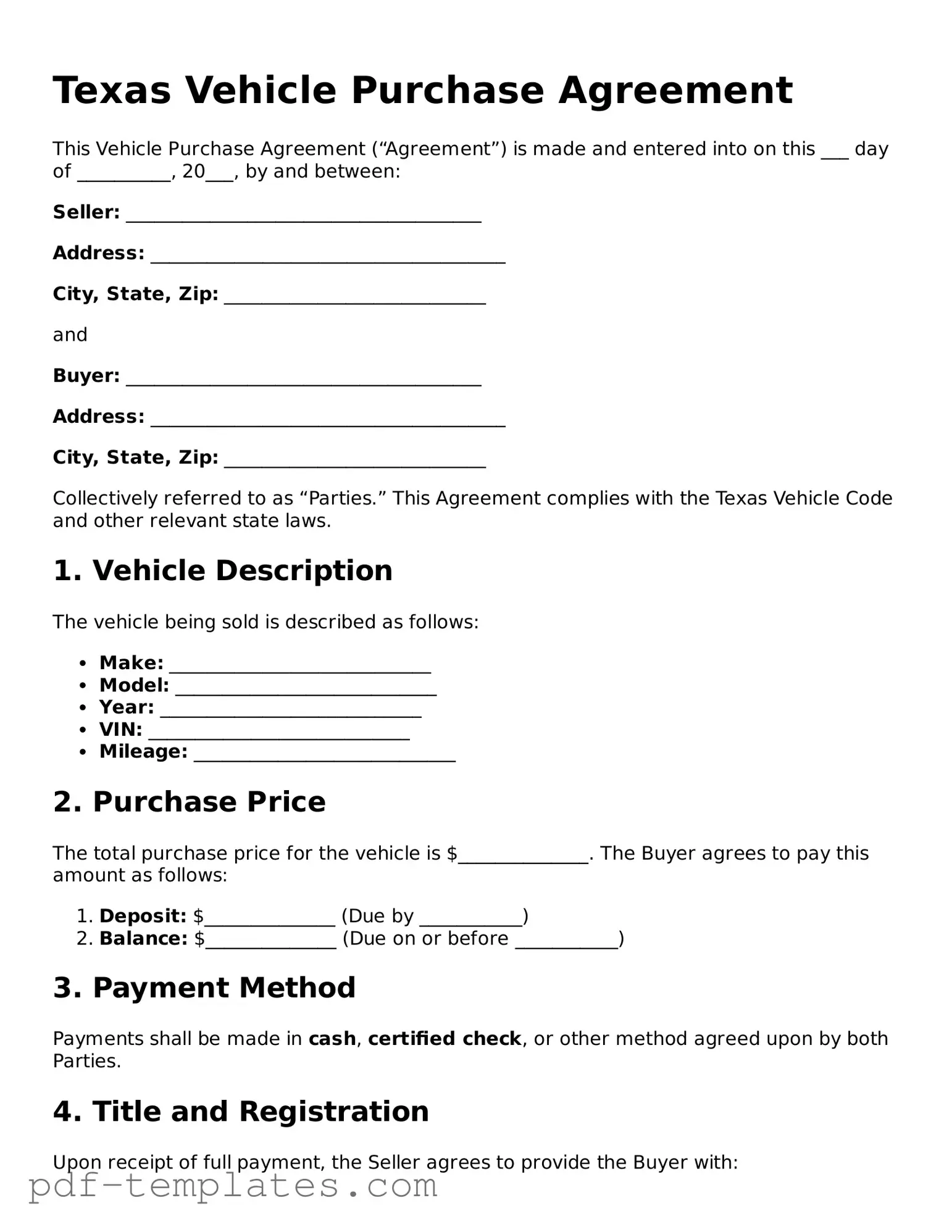The Texas Vehicle Purchase Agreement form shares similarities with the Bill of Sale. A Bill of Sale is a legal document that transfers ownership of a vehicle from the seller to the buyer. Both documents include essential information such as the vehicle's make, model, year, and Vehicle Identification Number (VIN). They also require signatures from both parties, confirming the sale and the agreed-upon price. This document acts as proof of the transaction and can be useful for registration and title purposes.
Another document that is similar is the Vehicle Title. The Vehicle Title serves as the official record of ownership for a vehicle. Like the Vehicle Purchase Agreement, it contains details about the vehicle and the owner's information. When a vehicle is sold, the title must be signed over to the new owner, ensuring that the transfer of ownership is legally recognized. Both documents play crucial roles in the process of buying and selling vehicles.
The Purchase Agreement is also comparable to the Lease Agreement. While a Lease Agreement outlines the terms for renting a vehicle, it shares a similar structure with the Vehicle Purchase Agreement. Both documents detail the parties involved, the vehicle information, and the terms of the agreement. They require signatures from both parties to validate the terms, ensuring that everyone understands their rights and responsibilities in the transaction.
The Sales Contract is another document that bears resemblance to the Texas Vehicle Purchase Agreement. A Sales Contract outlines the terms and conditions of a sale, including the purchase price and payment method. Like the Vehicle Purchase Agreement, it provides a clear record of the agreement between the buyer and seller. Both documents protect the interests of both parties and can be used in case of disputes or misunderstandings.
The Odometer Disclosure Statement is another important document related to vehicle sales. This form records the mileage of the vehicle at the time of sale, which is crucial for preventing fraud. Similar to the Vehicle Purchase Agreement, it requires signatures from both the buyer and the seller. This document ensures that the buyer is aware of the vehicle's condition and history, providing transparency in the transaction.
The Warranty Deed can also be compared to the Vehicle Purchase Agreement in terms of its function. While a Warranty Deed transfers real property, it shares a similar purpose of confirming the transfer of ownership. Both documents provide a legal basis for ownership and require signatures from the parties involved. They serve as evidence of the transaction and help protect the rights of the new owner.
Additionally, the Affidavit of Heirship is relevant in situations where a vehicle is inherited. This document establishes the rightful ownership of a vehicle when it is passed down through family members. It has similarities to the Vehicle Purchase Agreement in that it must include details about the vehicle and the parties involved. Both documents are essential for ensuring that ownership is legally recognized and can prevent disputes among heirs.
Lastly, the Power of Attorney can be related to the Vehicle Purchase Agreement in terms of authority. A Power of Attorney allows one person to act on behalf of another in legal matters, including the sale of a vehicle. This document can be used when the seller cannot be present for the transaction. Like the Vehicle Purchase Agreement, it requires signatures and specifies the terms under which the agent can operate, ensuring that the sale is conducted legally and properly.
